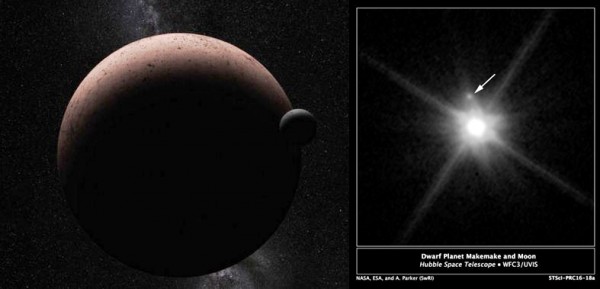Newly Discovered Black Moon of Dwarf Planet Makemake Named MK2
| Arthur Dominic Villasanta | | Apr 27, 2016 09:24 AM EDT |
(Photo : NASA) (Left) Artists's concept of Makemake and its moon, MK2. (Right) What these two objects look like to astronomers. The arrow points to MK2.
Astronomers have given the newly discovered moon of the dwarf planet Makemake in the Kuiper Belt the provisional name of named S/2015 (136472) 1, or MK 2 for short. They're now turning their attention to finding other moons on Makemake and the other three dwarf planets in the Kuiper Belt.
Like Us on Facebook
On April 26, astronomers announced the discovery of the first moon known to orbit the second brightest object in the Kuiper Belt. They used NASA's orbiting Hubble Space Telescope to spot the miniscule moon located 5.91 billion miles from Earth.
What scientists find odd about MK 2 is that it's an extremely dark moon with a reflectivity like charcoal. The dark surface of MK2 also made it very difficult to discover against the glare of Makemake, a factor that prevented the moon from being discovered earlier.
Makemake orbits the sun at an average distance of 45.7 astronomical units (AU). It completes one revolution around the sun every 309 Earth years. Makemake is even farther away than Pluto, whose average distance from the sun is 39.5 AU. An AU is equivalent to some 150 million kilometers, which is the distance from the sun to the Earth.
Alex Parker, leader of the team that analyzed the Hubble images, said the orbit of MK2 appears to be aligned edge-on to Earth, making it more difficult to detect because of Makemake's intense glare. One explanation for the dark surface is that the moon's gravity is too weak to retain reflective ices, which then evaporate into space.
From observations, astronomers can infer the following about MK2. The black moon is estimated to be about 160 kilometers in diameter and orbits some 20,900 kilometers above the surface of Makemake.
Parker said the discovery of MK2 gives scientists the chance to study Makemake in far greater detail. Observing the orbit of MK2 could allow scientists to determine the density of Makemake, which in turn might reveal if this dwarf planet and Pluto are made of similar materials.
Makemake is named after the Rapa Nui god that created humanity. He is also the god of fertility and the chief god of the "Tangata manu" or the bird-man cult.
TagsS/2015, Black Moon of Dwarf Planet, kuiper belt, dwarf planets, moons on Makemake, Hubble Space Telescope, MK 2
©2015 Chinatopix All rights reserved. Do not reproduce without permission
EDITOR'S PICKS
-

Did the Trump administration just announce plans for a trade war with ‘hostile’ China and Russia?
-

US Senate passes Taiwan travel bill slammed by China
-

As Yan Sihong’s family grieves, here are other Chinese students who went missing abroad. Some have never been found
-

Beijing blasts Western critics who ‘smear China’ with the term sharp power
-

China Envoy Seeks to Defuse Tensions With U.S. as a Trade War Brews
-

Singapore's Deputy PM Provides Bitcoin Vote of Confidence Amid China's Blanket Bans
-

China warns investors over risks in overseas virtual currency trading
-

Chinese government most trustworthy: survey
-

Kashima Antlers On Course For Back-To-Back Titles
MOST POPULAR
LATEST NEWS
Zhou Yongkang: China's Former Security Chief Sentenced to Life in Prison

China's former Chief of the Ministry of Public Security, Zhou Yongkang, has been given a life sentence after he was found guilty of abusing his office, bribery and deliberately ... Full Article
TRENDING STORY

China Pork Prices Expected to Stabilize As The Supplies Recover

Elephone P9000 Smartphone is now on Sale on Amazon India

There's a Big Chance Cliffhangers Won't Still Be Resolved When Grey's Anatomy Season 13 Returns

Supreme Court Ruled on Samsung vs Apple Dispute for Patent Infringement

Microsoft Surface Pro 5 Rumors and Release Date: What is the Latest?












